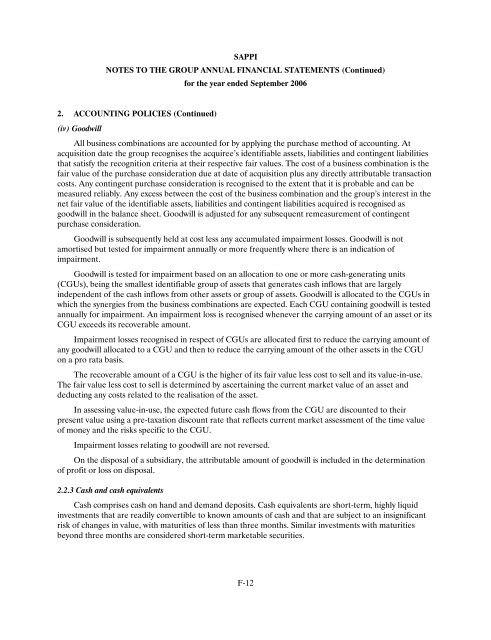You also want an ePaper? Increase the reach of your titles
YUMPU automatically turns print PDFs into web optimized ePapers that Google loves.
SAPPI<br />
NOTES TO THE GROUP ANNUAL FINANCIAL STATEMENTS (Continued)<br />
for the year ended September <strong><strong>20</strong>06</strong><br />
2. ACCOUNTING POLICIES (Continued)<br />
(iv) Goodwill<br />
All business combinations are accounted for by applying the purchase method of accounting. At<br />
acquisition date the group recognises the acquiree’s identifiable assets, liabilities and contingent liabilities<br />
that satisfy the recognition criteria at their respective fair values. The cost of a business combination is the<br />
fair value of the purchase consideration due at date of acquisition plus any directly attributable transaction<br />
costs. Any contingent purchase consideration is recognised to the extent that it is probable and can be<br />
measured reliably. Any excess between the cost of the business combination and the group’s interest in the<br />
net fair value of the identifiable assets, liabilities and contingent liabilities acquired is recognised as<br />
goodwill in the balance sheet. Goodwill is adjusted for any subsequent remeasurement of contingent<br />
purchase consideration.<br />
Goodwill is subsequently held at cost less any accumulated impairment losses. Goodwill is not<br />
amortised but tested for impairment annually or more frequently where there is an indication of<br />
impairment.<br />
Goodwill is tested for impairment based on an allocation to one or more cash-generating units<br />
(CGUs), being the smallest identifiable group of assets that generates cash inflows that are largely<br />
independent of the cash inflows from other assets or group of assets. Goodwill is allocated to the CGUs in<br />
which the synergies from the business combinations are expected. Each CGU containing goodwill is tested<br />
annually for impairment. An impairment loss is recognised whenever the carrying amount of an asset or its<br />
CGU exceeds its recoverable amount.<br />
Impairment losses recognised in respect of CGUs are allocated first to reduce the carrying amount of<br />
any goodwill allocated to a CGU and then to reduce the carrying amount of the other assets in the CGU<br />
on a pro rata basis.<br />
The recoverable amount of a CGU is the higher of its fair value less cost to sell and its value-in-use.<br />
The fair value less cost to sell is determined by ascertaining the current market value of an asset and<br />
deducting any costs related to the realisation of the asset.<br />
In assessing value-in-use, the expected future cash flows from the CGU are discounted to their<br />
present value using a pre-taxation discount rate that reflects current market assessment of the time value<br />
of money and the risks specific to the CGU.<br />
Impairment losses relating to goodwill are not reversed.<br />
On the disposal of a subsidiary, the attributable amount of goodwill is included in the determination<br />
of profit or loss on disposal.<br />
2.2.3 Cash and cash equivalents<br />
Cash comprises cash on hand and demand deposits. Cash equivalents are short-term, highly liquid<br />
investments that are readily convertible to known amounts of cash and that are subject to an insignificant<br />
risk of changes in value, with maturities of less than three months. Similar investments with maturities<br />
beyond three months are considered short-term marketable securities.<br />
F-12
















